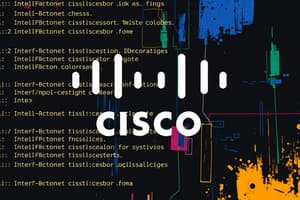Podcast
Questions and Answers
What is the primary purpose of dynamic routing protocols?
What is the primary purpose of dynamic routing protocols?
- To define routes to specific networks
- To provide a backup route when the primary fails
- To maintain up-to-date routing tables and adjust to network changes (correct)
- To forward all packets without a specific match
Which of the following describes a floating static route?
Which of the following describes a floating static route?
- A default route that forwards all packets
- A backup route activated when the primary route fails (correct)
- A route to a specific network that is always active
- A route that maintains a complete view of the network topology
What distinguishes Classless protocols from Classful protocols?
What distinguishes Classless protocols from Classful protocols?
- Classful protocols share subnet mask information
- Classless protocols do not support VLSM
- Classless protocols provide flexibility in addressing with CIDR support (correct)
- Classful protocols automatically adjust to network topology changes
Which of the following statements about Distance-Vector protocols is true?
Which of the following statements about Distance-Vector protocols is true?
What is a key disadvantage of dynamic routing protocols?
What is a key disadvantage of dynamic routing protocols?
Which of the following accurately describes a characteristic of a LAN?
Which of the following accurately describes a characteristic of a LAN?
What is a key feature of WANs in comparison to LANs?
What is a key feature of WANs in comparison to LANs?
Which network component is responsible for the management of data flow?
Which network component is responsible for the management of data flow?
Which of the following aspects of network architecture enhances its reliability?
Which of the following aspects of network architecture enhances its reliability?
What distinguishes cloud computing from traditional computing models?
What distinguishes cloud computing from traditional computing models?
Which of the following is considered an external threat to network security?
Which of the following is considered an external threat to network security?
In communication rules, which elements are essential for successful interaction?
In communication rules, which elements are essential for successful interaction?
What is the primary method for secure remote access in Cisco IOS?
What is the primary method for secure remote access in Cisco IOS?
Which command is used to enter Global Configuration Mode in Cisco IOS?
Which command is used to enter Global Configuration Mode in Cisco IOS?
Which characteristic of IP ensures that there is no guarantee of packet delivery or order?
Which characteristic of IP ensures that there is no guarantee of packet delivery or order?
Which command is used in Cisco IOS to secure privileged EXEC access?
Which command is used in Cisco IOS to secure privileged EXEC access?
In which mode can you configure specific port settings on a Cisco device?
In which mode can you configure specific port settings on a Cisco device?
Which of the following is NOT a valid header field in IPv4 packets?
Which of the following is NOT a valid header field in IPv4 packets?
What does the TTL field in an IPv4 header signify?
What does the TTL field in an IPv4 header signify?
Which access method is considered insecure and should be avoided when managing Cisco devices?
Which access method is considered insecure and should be avoided when managing Cisco devices?
Which mode in Cisco IOS allows you to execute view-only commands?
Which mode in Cisco IOS allows you to execute view-only commands?
What is a primary advantage of IPv6 over IPv4?
What is a primary advantage of IPv6 over IPv4?
Which routing table entry type is labeled as 'C' in a router's routing table?
Which routing table entry type is labeled as 'C' in a router's routing table?
In IPv4 addressing, which component denotes the division between the network and host portions?
In IPv4 addressing, which component denotes the division between the network and host portions?
What component of a router is responsible for storing the IOS?
What component of a router is responsible for storing the IOS?
Which address type allows communication from one device to multiple devices on a group?
Which address type allows communication from one device to multiple devices on a group?
What is the first step in a router's boot-up process?
What is the first step in a router's boot-up process?
How is the default gateway typically assigned in a network?
How is the default gateway typically assigned in a network?
What identifies a device's local IP address in the router routing table?
What identifies a device's local IP address in the router routing table?
Which type of IPv4 address is not routable on the internet?
Which type of IPv4 address is not routable on the internet?
What is the role of the console interface on a router?
What is the role of the console interface on a router?
How many hosts can be supported in a /27 subnet?
How many hosts can be supported in a /27 subnet?
What is the magic number for calculating subnet ranges for a /26 subnet?
What is the magic number for calculating subnet ranges for a /26 subnet?
What subnet mask would you use for a network requiring 200 hosts?
What subnet mask would you use for a network requiring 200 hosts?
Which of the following represents the correct subnet range for a /25 subnet?
Which of the following represents the correct subnet range for a /25 subnet?
Which statement is true regarding Variable Length Subnet Masking (VLSM)?
Which statement is true regarding Variable Length Subnet Masking (VLSM)?
What is a primary disadvantage of manually configured routes?
What is a primary disadvantage of manually configured routes?
Which of the following is NOT a benefit of using VLSM?
Which of the following is NOT a benefit of using VLSM?
What does the process of subnetting allow a network administrator to achieve?
What does the process of subnetting allow a network administrator to achieve?
What is the correct formula for calculating the number of hosts per subnet?
What is the correct formula for calculating the number of hosts per subnet?
Which type of IP assignment is typically used for servers?
Which type of IP assignment is typically used for servers?
LANs are designed to cover large geographic areas, such as cities or countries.
LANs are designed to cover large geographic areas, such as cities or countries.
The Internet is simply a collection of multiple WANs interconnected with various media types.
The Internet is simply a collection of multiple WANs interconnected with various media types.
Packet switching improves security by encrypting all data transmitted over the network.
Packet switching improves security by encrypting all data transmitted over the network.
BYOD stands for 'Bring Your Own Device,' which refers to employees using their personal gadgets for work.
BYOD stands for 'Bring Your Own Device,' which refers to employees using their personal gadgets for work.
Intermediary devices include components such as computers and smartphones.
Intermediary devices include components such as computers and smartphones.
Quality of Service (QoS) is a principle that helps in providing security by encrypting sensitive data.
Quality of Service (QoS) is a principle that helps in providing security by encrypting sensitive data.
A reliable network architecture is characterized by scalability, which allows growth without impacting performance.
A reliable network architecture is characterized by scalability, which allows growth without impacting performance.
The subnet mask /16 indicates that 16 bits are used for the host portion of the address.
The subnet mask /16 indicates that 16 bits are used for the host portion of the address.
ICMP is utilized by the ping tool to check the latency of packets traveling to a local host.
ICMP is utilized by the ping tool to check the latency of packets traveling to a local host.
Link-Local addresses begin with the IP range 192.168.0.0/16.
Link-Local addresses begin with the IP range 192.168.0.0/16.
Class B addresses span from 128.0.0.0 to 191.255.255.255.
Class B addresses span from 128.0.0.0 to 191.255.255.255.
The process of subnetting divides larger networks into broadcast domains to enhance performance.
The process of subnetting divides larger networks into broadcast domains to enhance performance.
Cisco IOS provides a Command-Line Interface (CLI) solely for viewing configurations.
Cisco IOS provides a Command-Line Interface (CLI) solely for viewing configurations.
SSH is a secure method for remote access to network devices.
SSH is a secure method for remote access to network devices.
The User EXEC Mode in Cisco IOS allows for advanced configuration commands.
The User EXEC Mode in Cisco IOS allows for advanced configuration commands.
Best Effort Delivery in the IP protocol guarantees the order of packet delivery.
Best Effort Delivery in the IP protocol guarantees the order of packet delivery.
In Cisco IOS, the 'enable' command is used to enter Global Configuration Mode.
In Cisco IOS, the 'enable' command is used to enter Global Configuration Mode.
The Console Port provides encrypted remote access to network devices.
The Console Port provides encrypted remote access to network devices.
IPv4 addresses consist of a version field that indicates it is an IPv4 packet.
IPv4 addresses consist of a version field that indicates it is an IPv4 packet.
The 'exit' command in Cisco IOS is used to save the running configuration to NVRAM.
The 'exit' command in Cisco IOS is used to save the running configuration to NVRAM.
Media independence in the IP protocol means it can operate over various media types like copper and fiber.
Media independence in the IP protocol means it can operate over various media types like copper and fiber.
The term 'de-encapsulation' refers to the process of sending packets in the network layer.
The term 'de-encapsulation' refers to the process of sending packets in the network layer.
Protocols manage message formatting but do not govern timing or delivery.
Protocols manage message formatting but do not govern timing or delivery.
Data encapsulation involves wrapping data in protocol layers such as files and folders.
Data encapsulation involves wrapping data in protocol layers such as files and folders.
The OSI model includes layers for Application, Presentation, and Session.
The OSI model includes layers for Application, Presentation, and Session.
A WAN typically operates over a small geographic area with lower speed compared to a LAN.
A WAN typically operates over a small geographic area with lower speed compared to a LAN.
IP addresses only provide data link delivery between devices on the same network.
IP addresses only provide data link delivery between devices on the same network.
Confidentiality in network security ensures reliable access for unauthorized users.
Confidentiality in network security ensures reliable access for unauthorized users.
Encapsulation occurs in a sequence from application data to frames as data moves across the network.
Encapsulation occurs in a sequence from application data to frames as data moves across the network.
The MAC address is used to identify the source and destination for IP packets.
The MAC address is used to identify the source and destination for IP packets.
BYOD refers to the practice of accessing the network with personal devices.
BYOD refers to the practice of accessing the network with personal devices.
IPv6 has a smaller address space compared to IPv4.
IPv6 has a smaller address space compared to IPv4.
The default gateway is used for sending packets to devices on the same network.
The default gateway is used for sending packets to devices on the same network.
NVRAM is utilized to store both the running and startup configuration of a router.
NVRAM is utilized to store both the running and startup configuration of a router.
The BOOT process of a router begins with loading the IOS from NVRAM.
The BOOT process of a router begins with loading the IOS from NVRAM.
Unicast communication refers to one-to-many communication.
Unicast communication refers to one-to-many communication.
The subnet mask for a Class C IPv4 address is typically represented as /24.
The subnet mask for a Class C IPv4 address is typically represented as /24.
Multicast addresses range from 192.0.0.0 to 223.255.255.255.
Multicast addresses range from 192.0.0.0 to 223.255.255.255.
A router's routing table only contains directly connected routes.
A router's routing table only contains directly connected routes.
Cisco devices require console access during the initial configuration.
Cisco devices require console access during the initial configuration.
There are 1022 usable hosts in a /22 subnet.
There are 1022 usable hosts in a /22 subnet.
Flashcards
LAN
LAN
A network covering a small geographic area (home, office, or campus).
WAN
WAN
A network connecting LANs over large geographic areas (cities, countries).
Network Components
Network Components
Devices (end devices and intermediary) and media that manage data flow.
Network Architectures
Network Architectures
Signup and view all the flashcards
Fault Tolerance
Fault Tolerance
Signup and view all the flashcards
BYOD
BYOD
Signup and view all the flashcards
Packet Switching
Packet Switching
Signup and view all the flashcards
Cisco IOS
Cisco IOS
Signup and view all the flashcards
Command-Line Interface (CLI)
Command-Line Interface (CLI)
Signup and view all the flashcards
enable command
enable command
Signup and view all the flashcards
configure terminal command
configure terminal command
Signup and view all the flashcards
Connectionless Protocol
Connectionless Protocol
Signup and view all the flashcards
Best Effort Delivery
Best Effort Delivery
Signup and view all the flashcards
IPv4 Header Fields
IPv4 Header Fields
Signup and view all the flashcards
Network Layer
Network Layer
Signup and view all the flashcards
IPv6 Header
IPv6 Header
Signup and view all the flashcards
IPv6 Addresses
IPv6 Addresses
Signup and view all the flashcards
Default Gateway
Default Gateway
Signup and view all the flashcards
Host Routing Table
Host Routing Table
Signup and view all the flashcards
Directly Connected Routes
Directly Connected Routes
Signup and view all the flashcards
Subnet Mask
Subnet Mask
Signup and view all the flashcards
Unicast Address
Unicast Address
Signup and view all the flashcards
Router RAM
Router RAM
Signup and view all the flashcards
Router Flash Memory
Router Flash Memory
Signup and view all the flashcards
Router Boot Process
Router Boot Process
Signup and view all the flashcards
Static Route
Static Route
Signup and view all the flashcards
Default Static Route
Default Static Route
Signup and view all the flashcards
Dynamic Routing
Dynamic Routing
Signup and view all the flashcards
Distance-Vector Routing
Distance-Vector Routing
Signup and view all the flashcards
Link-State Routing
Link-State Routing
Signup and view all the flashcards
Subnetting
Subnetting
Signup and view all the flashcards
Subnetting Calculation
Subnetting Calculation
Signup and view all the flashcards
Magic Number
Magic Number
Signup and view all the flashcards
Structured Addressing
Structured Addressing
Signup and view all the flashcards
Advantages of Static Routing
Advantages of Static Routing
Signup and view all the flashcards
Disadvantages of Static Routing
Disadvantages of Static Routing
Signup and view all the flashcards
Protocol Function
Protocol Function
Signup and view all the flashcards
Data Encapsulation
Data Encapsulation
Signup and view all the flashcards
IP (Internet Protocol)
IP (Internet Protocol)
Signup and view all the flashcards
OSI Model
OSI Model
Signup and view all the flashcards
TCP/IP Model
TCP/IP Model
Signup and view all the flashcards
Network Security Goals
Network Security Goals
Signup and view all the flashcards
LAN vs. WAN
LAN vs. WAN
Signup and view all the flashcards
Cloud Computing
Cloud Computing
Signup and view all the flashcards
Sender, Receiver, Medium
Sender, Receiver, Medium
Signup and view all the flashcards
What are end devices?
What are end devices?
Signup and view all the flashcards
What are intermediary devices?
What are intermediary devices?
Signup and view all the flashcards
What is fault tolerance?
What is fault tolerance?
Signup and view all the flashcards
What is QoS?
What is QoS?
Signup and view all the flashcards
What are the main network security threats?
What are the main network security threats?
Signup and view all the flashcards
Cisco IOS Purpose
Cisco IOS Purpose
Signup and view all the flashcards
Console Port Access
Console Port Access
Signup and view all the flashcards
SSH Access
SSH Access
Signup and view all the flashcards
User EXEC Mode
User EXEC Mode
Signup and view all the flashcards
Privileged EXEC Mode
Privileged EXEC Mode
Signup and view all the flashcards
Global Configuration Mode
Global Configuration Mode
Signup and view all the flashcards
Interface Mode
Interface Mode
Signup and view all the flashcards
Save Configuration to NVRAM
Save Configuration to NVRAM
Signup and view all the flashcards
IPv4 Packet
IPv4 Packet
Signup and view all the flashcards
IPv6 Address Space
IPv6 Address Space
Signup and view all the flashcards
IPv6 Header Structure
IPv6 Header Structure
Signup and view all the flashcards
Default Gateway Role
Default Gateway Role
Signup and view all the flashcards
Router Routing Table
Router Routing Table
Signup and view all the flashcards
Public vs. Private Address
Public vs. Private Address
Signup and view all the flashcards
What does /24 represent in an IP address?
What does /24 represent in an IP address?
Signup and view all the flashcards
What are Private IP addresses?
What are Private IP addresses?
Signup and view all the flashcards
What is the purpose of ping?
What is the purpose of ping?
Signup and view all the flashcards
Study Notes
Chapter 1: Introduction to Networks
- Networks connect devices globally for communication, learning, work, and entertainment.
- Communication methods include texting, social media, online collaboration, blogs and gaming.
Chapter 2/1: Key Topics on Networking
- All communication requires a sender, receiver, and medium (channel).
- Protocols govern message formatting, timing, delivery, and acknowledgement.
- Data encapsulation wraps data in protocol layers, like envelopes.
Chapter 2/2: Configure a Network Operating System
- Cisco IOS is the operating system for network devices (routers, switches).
- Cisco IOS uses CLI (Command Line Interface) for management.
- Access methods include the console port (physical access) and secure shell (SSH) for encrypted remote access.
Chapter 3: Network Layer Overview
- The network layer handles addressing, encapsulation, routing, and de-encapsulation for end-to-end communication.
- Protocols IPv4 and IPv6 are commonly implemented.
- IP is a connectionless protocol for best-effort data delivery that doesn't guarantee order.
Chapter 4: IPv4 Addressing Basics
- IPv4 addresses are 32-bit binary numbers divided into 4 octets (e.g., 192.168.1.1).
- Addresses consist of network and host portions defined by a subnet mask (e.g., /24 equals 255.255.255.0).
- Address types include unicast (one-to-one), broadcast (one-to-all), and multicast (one-to-a-group).
- IPv4 addresses are categorized as public (routable on the internet) or private (not routable externally).
Chapter 5: Subnetting
- Subnetting divides a larger network into smaller sub-networks for optimal performance and manageability.
- Subnetting principles involve defining how many bits are reserved for the network portion and remaining host bits.
- Formulas for calculating the number of subnets and hosts per subnet use the number of borrowed bits.
- Variable Length Subnet Masking (VLSM) optimizes IP address usage by providing subnets of various sizes.
Chapter 6: Static Routing Basics
- Static routes are configured manually in a routing table for network management.
- Advantages include enhanced security and predictable data paths.
- Disadvantages include time-consuming configuration, maintenance errors, and limited scalability.
Chapter 7: Dynamic Routing
- Dynamic routing protocols discover and maintain routing information automatically.
- Advantages include ease of administration and adaptability to network changes.
- Disadvantages include increased overhead and potential slower convergence.
- Routing protocols include Distance-Vector (e.g., RIP, EIGRP) and Link-State (e.g., OSPF, IS-IS).
Chapter 8: OSPF
- OSPF (Open Shortest Path First) is a link-state routing protocol used within an Autonomous System.
- OSPF features include fast convergence, scalability, and utilization of cost as a metric for best path determination.
- OSPF utilizes Link-State Advertisements (LSAs) to exchange topology information.
Additional Notes
- Routers and gateways use static IPs for management.
- Proper planning and documentation are critical for network management.
- Testing tools include ping and traceroute.
- Practical application involves understanding protocol layers, address types, subnetting and routing concepts along with implementation using practical commands.
Studying That Suits You
Use AI to generate personalized quizzes and flashcards to suit your learning preferences.




